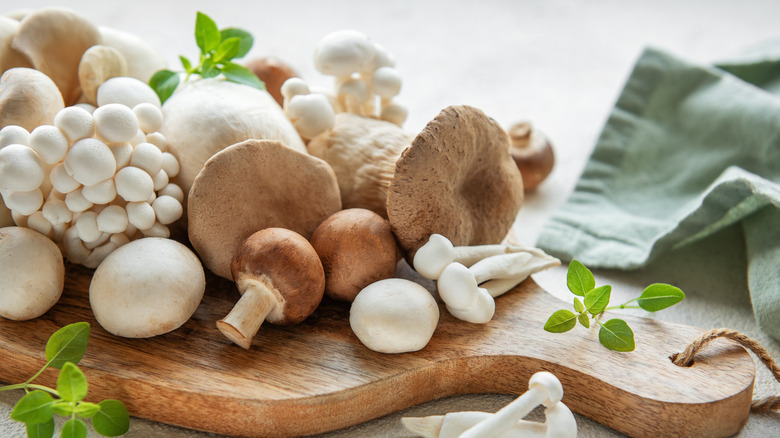The Flavor-Boosting Ingredient Emeril Lagasse Adds To Chicken Noodle Soup
Chicken noodle soup is a classic dish for a reason. It's full of protein, packed with vegetables, and has a hearty saltiness that consistently satisfies even the hungriest eater. But one of the biggest mistakes everyone makes when cooking chicken soup is overthinking the ingredients. Those that do should take a tip from Emeril Lagasse. When he wants to boost his simple chicken noodle soup recipe, he turns to one ingredient: mushrooms.
Most mushrooms are porous and if dropped in any liquid, oil, or fat, they will absorb it. To avoid this problem Lagasse quarters his mushrooms, and then sautés them in a bit of vegetable, browning their exteriors and creating a roasted richness that adds more overall depth to his soup. If you want to use less oil in the sautéing process, add enough water to cover the bottom of the pan, simmer the mushrooms for a couple of minutes, and then let the water evaporate. This drives out the excess moisture in the mushrooms and lets you use less cooking fat to properly develop the flavor.
The result is an antioxidant-rich powerhouse of taste that contributes to the heartiness and texture of this cold weather classic with very little effort. But while you may be used to using standard buttoncap, portobello, or bella mushrooms, don't be afraid to experiment! The world of edible fungi has all sorts of options, and just about any type of mushroom can be cooked in soup.
Unique mushrooms to use in your soup
Whether you're looking for texture or taste, there's a fungus for every function. There are tons of insider tricks restaurants use to make the most delicious mushrooms and maximize their flavor, but some need different treatment than others.
If you want something to complement your noodles or even replace them entirely, consider enoki or beech mushrooms. These small, stringy delights grow in clusters, but you can easily strip off individual stocks and sauté them before adding to the soup, or just toss them in raw. Beech mushrooms have a firm texture and nutty flavor, while enokis are far softer, with a more neutral taste. If you use enokis, add them raw or only give them a quick sauté , as they may become mushy.
If you're looking for something with more substance, try dipping your toe into the oyster mushroom family. Regular oyster mushrooms are great because you can cut them into chunks or finely dice them, giving you a little taste in every bite. King oysters are one of the meatiest varieties you can find, especially when sliced into thick discs and browned in butter. If you sauté them beforehand, do it over high heat to develop the right flavor, and then let them simmer in the broth to achieve your desired texture. However, you should avoid sautéing oyster mushrooms for too long; that may make them grow tough, as they're quite dense.


